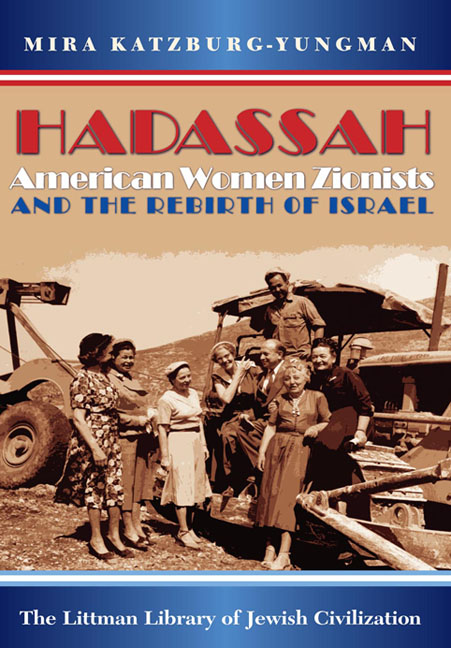Book contents
- Frontmatter
- Dedication
- Preface and Acknowledgements
- Contents
- List of Plates
- Note on Transliteration
- Prologue
- PART I CONTEXTS AND CHALLENGES
- PART II THE AMERICAN SCENE: IDEOLOGY AND PRACTICE
- PART III THE WORLD ZIONIST ORGANIZATION SCENE
- PART IV THE ISRAELI SCENE: HADASSAH AND THE NEW STATE
- PART V HADASSAH IN CONTEXT
- 12 Comparative and Feminist Perspectives
- 13 Hadassah's Partners
- Epilogue
- APPENDICES
- Bibliography
- Plate Acknowledgements
- Index
Epilogue
from PART V - HADASSAH IN CONTEXT
- Frontmatter
- Dedication
- Preface and Acknowledgements
- Contents
- List of Plates
- Note on Transliteration
- Prologue
- PART I CONTEXTS AND CHALLENGES
- PART II THE AMERICAN SCENE: IDEOLOGY AND PRACTICE
- PART III THE WORLD ZIONIST ORGANIZATION SCENE
- PART IV THE ISRAELI SCENE: HADASSAH AND THE NEW STATE
- PART V HADASSAH IN CONTEXT
- 12 Comparative and Feminist Perspectives
- 13 Hadassah's Partners
- Epilogue
- APPENDICES
- Bibliography
- Plate Acknowledgements
- Index
Summary
HADASSAH HAS BEEN ACTIVE in the United States and in Israel (the two largest concentrations of the Jewish people today) for a century now. Amazingly, despite the changing times and circumstances, much of what has been said of it over those years was still true when I was collecting the material for this epilogue in 2005 (terms such as ‘currently’ and ‘today’ used here relate to that year).
Hadassah's organizational identity and its fundamental objectives and goals, as they were worded in the 1956 constitution (see Appendix C), remained unchanged until 1999. At that time a small amendment was made, but it entailed no substantial change either to its objectives and goals or to its organizational identity. According to three central figures in Hadassah in the past thirty years, Bernice Tannenbaum (president from 1976 to 1980), Ruth Popkin (president from 1984 to 1988), and Marlene Edith Post (president from 1995 to 1999), ‘the ideology has not changed, the basic goals have not changed—it is the practice which has changed.’
And so today, as in the 1940s and 1950s, Hadassah's ideology is aimed at responding to the needs of American Jews in accordance with their fundamental values. It encompasses American ideals, including the fundamental notions of American democracy, as almost sacrosanct values, and reflects the desire to ensure that the next generation will continue to live as Jews. Because Hadassah's Zionism combines elements of American ideology and American patriotism, traditional Jewish ideas, and ideas considered by very many American Jews as common to both Judaism and Americanism, it appeals to Jews with varying Jewish perspectives and of varying political affiliations.
The precipitous rise in the last three decades of the twentieth century in the rate of mixed marriage in the American Jewish community—which had been a marginal phenomenon (3–5 per cent) until the end of the 1950s—has wrought a change in Hadassah's financial priorities, particularly with regard to its educational activity among Jewish youth in the United States. Currently, Hadassah allocates the second-largest segment of its budget, after its health enterprises in Israel, to the Young Judaea youth movement, which aims to reach all streams of Judaism (Reform, Conservative, Orthodox, and Reconstructionist) as well as Jews who are not affiliated with any stream, and regards its principal role as developing a deepseated Jewish identity and a strong identification with Judaism and Israel.
- Type
- Chapter
- Information
- HadassahAmerican Women Zionists and the Rebirth of Israel, pp. 293 - 306Publisher: Liverpool University PressPrint publication year: 2011

